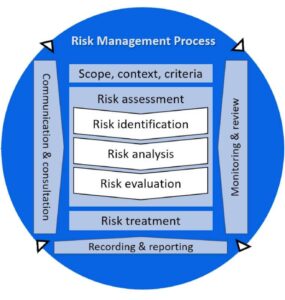Emergency rescue procedure

Emergency rescue procedure is an important procedure to be made before starting any work activity.
1.0 PURPOSE
The purpose of this procedure is to establish basic guidelines to ensure rapid and effective response during any emergency/ crisis situation during work. This procedure is also a guideline for the employer to accurately monitor and have total control of all personnel involved and to accurately monitor the headcount during an emergency.
2.0 Scope
This procedure covers basic Emergency Assistance, Rescue Operations, and Personnel Evacuation and Security Control guidelines during an emergency situation.
3.0 Responsibilities
- Project Manager ( PM )
- Construction Managers ( CM )
- Site Supervisors ( SS )
- Site Foremen ( SF )
- Safety Personnel ( SO )
- ERT Supervisor ( ERT )
- Security Personnel ( SEC )
4.0 Objectives
The Emergency Response Plan (ERP) is developed to deal with emergencies during construction works. The ERP provides guidelines for execution during an emergency. The objectives are: To establish and implement a formalized mechanism to effectively manage, control and contain emergency situations.
To define the roles and responsibilities of all identified personnel. Those personnel present on-site including employees, contractors, and visitors during an emergency situation.
To provide procedures to restore normality. At the site prior to the re-entry of personnel to resume work after the declaration of emergency termination.
To maintain a record of emergency incidents for investigation. The aim is to minimize or prevent a similar occurrence.
To initiate and maintain an effective communication system. and coordination during emergencies as well as with local regulatory authorities and rescue agencies.
To identify emergency response training needs, and schedule drills or exercises for identified personnel and site employees to maintain a high level of preparedness.
5.0 Definition
Emergency: Any unplanned event, which has the potential to cause injury to people, damage to property and environment and loss to production or combination of all the above, which requires immediate action to control the situation.
Emergency Team: Trained personnel on basic emergency required an evacuation of personnel from work areas in an emergency situation and assist relevant authorities when required.
Assembly point: A safe location, where personnel on the scene of an emergency, who are not involved in the rescue team, are to assemble. The attendance of the assembled personnel will be taken to ensure everyone is accountable.
First responder: Any person who first detects the emergency.
6.0 Types of Emergency
There are few possibilities of an emergency such as:
- Explosion
- Flooding
- Structure Collapse
- Fire
- Traffic / Vehicle collision
- Spill
- Injury
- Heavy rainfall beyond the capacity of erosion and sediment controls.
- Discovery of contaminated material on site.
7.0 Procedure
7.1 Basic Emergency alert call
- Personnel that detects the emergency shall call for Emergency Alert by phone/intercom or other quickest means possible to the ERT Supervisor.
- Upon hearing the Emergency call, the ERT Supervisor shall respond to the Emergency caller and confirm the alert call.
- ERT Supervisor shall then record all the particulars of the emergency, time, the action is taken and rescue authorities’ arrival. He shall then inform the Safety Officer, Site Supervisor.
- The Section In-charge and Safety Officer shall decide for any Authorities Rescue Assistance if required. [999].
8.0 Emergency Response Team Responsibilities
The roles and responsibilities of identified personnel during an emergency are clearly defined. The Emergency Response Team (ERT) will be responsible for the following:
- Providing immediate response to the emergency either to terminate or rescue or, if possible, contain the situation until the arrival of external emergency services or assistance.
- Assisting external emergency services by providing them appropriate information on the condition of the emergency as well as the operations and procedures carried out by the ERT team. (In case of the Ambulance coming to the site will be directed from the gate by appointing an escort to guide them to the right place and back again).
- The Ministry of Work will be informed immediately of any Emergency by the Engineer.
- Acting as the focal point for the ERT team, including imparting training to maintain a high degree of preparedness, conducting drills and ensuring the effectiveness of the ERP. Emergency rescue procedure.
9.0 ROLES AND RESPONSIBILITIES OF THE EMERGENCY RESPONSE TEAM
ERT SUPERVISOR
The main responsibility of the ERT Supervisor is to assist the site personnel in the event of an emergency. He will perform emergency response actions at the scene of the emergency as directed by the Safety Officer. He has the following responsibilities:
- Being present at the scene of an emergency and monitoring the situation.
- Liaising directly with external agencies upon their arrival on-site .e.g. Fire Services (Civil Defense), Medical Services, Rescue Team, Police, etc…
- Reporting the development or status of the emergency to the Safety Officer.
- Providing guidance on the response strategy to be implemented by the ERT members.
- Certifying any rectification work done by ERT members.
- Performing internal and external notification, including call out of external emergency services.
- Preparing proper records of the incident for the ERT Supervisor to facilitate investigations.
- Ensure that all other employees are assembled at the designated assembly point during evacuation and coordinating a headcount.
- Informing the ERT Leader of any missing personnel, if any.
- Assist the Medic to administer First Aid to injured personnel, if necessary.
ERT MEMBERS
The ERT members are to take actions for controlling or minimizing the effect of an emergency. Upon activation of the emergency, they are responsible for the following:
- Assist the Medic in administering First Aid to the injured personnel.
- Transport injured personnel to the nearest Medical Centre, Hospital or Clinic.
- Fire Fighters.
- Carrying out search and rescue as instructed by the ERT Supervisor.
ERT Organization Chart
PROJECT MANAGE
Safety Officer
ERT Supervisor and ERT members
Emergency Equipment and Facilities
The following resources are minimum requirements to be provided for performing effective emergency response:
- Fire Fighting equipment and apparatus
- Basic Rescue equipment, stretcher, rope, etc.
- Signage
Listed is a sample of facilities and equipment to be made available: List of sample emergency related equipment must be provided along with the quantity of that equipment present at the workplace. for example the number of first aid kits, fire extinguishers, etc.
1.0 Termination of Emergency
As soon as the emergency is rendered safe, it is essential to ensure the safety and integrity of the job-site before the emergency is terminated.
Depending on the type and severity of the emergency, a specific procedure is outlined for re-entry into the job-site. Once the emergency is terminated, post-emergency actions are implemented.
The ERT Supervisor will declare “ALL CLEAR “once the emergency is terminated for normal operations to resume.
The following criteria must be met before declaring the termination of the emergency:
- The Job-site has been re-instated as in normal condition
- All rescue equipment and facilities removed from the job-site
- The ERT Members and team is fully prepared and equipped to handle subsequent emergencies
10.0 Debriefing
A debriefing session will be conducted after the emergency has been terminated. The ERT and all personnel involved in the emergency responses are required to attend the debriefing session. The ERT Supervisor will conduct and lead the debriefing session and address the following issues:
- Actions are taken during the emergency as outlined in the emergency procedure and any additional actions taken to control the incident.
- Safety measures to be taken after the termination of the emergency.
- Reports on the number of injuries as the result of the emergency.
- Follow-up activities.
- Feedback from ERT Members.
- Recommendations to prevent future recurrence or to improve emergency response actions.
- Selection of the Investigation Team and if necessary.
Incident Investigation and Reporting
A comprehensive Incident Investigation Report needs to be prepared, to evaluate the actual emergency response and the effectiveness of the emergency response actions. The Safety Officer is responsible to prepare all the Investigation reports and compiling all logs recorded. Emergency rescue procedure
However, the following elements need to be included in the report:
- Description of the incident and emergency response
The incident report details the date, time and location of the emergency as well as the emergency response process. These include:
- Subcontractor organization which responded to the emergency
- Debriefing
- Number of injured personnel
- Condition of injured personnel
- Parties involved in the rescue operation
- Preventive measures
- Facts of the Incident
The incident investigation report should include evidence to establish the causes of the incident, such as:
- Interview reports with the injured
- Interview reports with witnesses
- Photographs and sketches
- Causes of the Incident
The report should establish the causes of the incident based on the facts analyzed from the emergency scene and its surrounds.
- Recommendations
Shortfalls or safety concerns identified from the incident need to be addressed in the report and corrective measures, to prevent recurrence of the incident should be recommended.
12. Training clause: ISO 45001 clause No. 7.2
Training programs should make participants involved in emergency responses familiar and more knowledgeable of hazards and to provide the ERT Team with the confidence required when performing actual emergency actions.
The Section Head shall be responsible to ensure that regular training arrangements on a regular basis, possibly with relevant external rescue agencies. A schedule for the emergency response training will be in place to ensure a high level of emergency preparedness.
The various types of emergency response training to be implemented within the plan include:
- First Aid.
- Fire Fighting.
- Personal Protective Equipment usage.
- Oil Spillage.
13.0 Management Review_ ISO 45001:2018 Clause 9.3
13.1 Review
All additional equipment and changes in processes should be reviewed and incorporated.
13.2 Update / Amendment
After the review and recommendations made, updates and amendments to the ERP are necessary, to be in-line with construction progress.
14.0 emergency information:
Emergency numbers must be provided.










